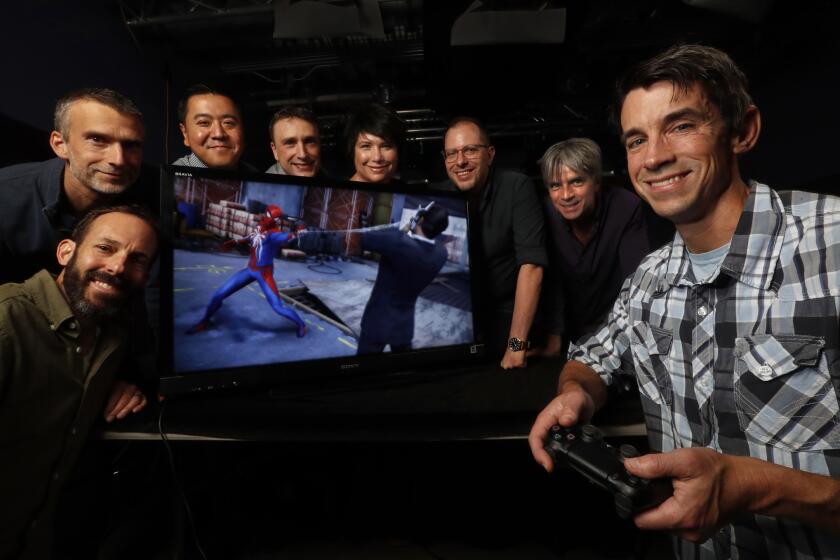Review: Why we should pay close attention to the world of ‘Spider-Man: Miles Morales’
Beneath the spritely and nimble action-adventure video game “Marvel’s Spider-Man: Miles Morales” — essentially a showcase of what the new PlayStation 5 can do — there is the nagging sensation that innocence will soon be shattered.
The game is set in pre-2020 New York, but it includes moments of cultural and societal tensions long experienced by many but which came to the fore this year.
Early, we see a privatized military force turn its guns on the teen hero of Puerto Rican and African American descent, his hands raised as bystanders turn on their smartphone cameras. It’s a chilling scene, recalling a number of the events that led to this year’s nationwide Black Lives Matter protests. Tragedy, in this instance, is only avoided due to Miles’ superhero abilities. Good fortune and good luck save what is played as a misunderstanding.
Later, we watch Morales’ mother, now running a political campaign, talk of the disappearing mom-and-pop shops throughout Harlem, which is on the verge of being gentrified by corporate interests. At this same political rally, we hear talk of an illness that could soon run rampant over the city: “No one’s gonna care about a few sick people. It’s the cost of doing business.”
Developed by Burbank’s Insomniac Games exclusively for the next-gen PlayStation 5 and PS4, “Spider-Man: Miles Morales” captures a city barreling toward an obsession with American individualism. Morales, voiced with earnestness and a bounty of positive energy by Nadji Jeter, is battling not just comic villains and evil energy companies but existential threats to his community, namely a pervading selfishness that’s increasingly led to a lack of institutional belief.
Morales is shown in the beginning of the game, for instance, idolizing his late father, a New York city cop, but slowly learns the vocation created rifts in his family. We linger a second on Morales’ face, but the full ramifications aren’t ones either Morales — or the game — appears ready to fully grapple with. Where the game excels, though, is in its character-building, Harlem-focused missions, which, while not a requirement to complete the main story, work hard to capture the soul of a community, one lost bodega cat at a time.
When rushing to play a game ahead of its release — “Miles Morales” launches today with the PS5 — there’s a tendency to avoid detours and instead focus on the core narrative to simply finish the game. But in “Miles Morales” I chose instead to linger and explore the city, in part because soaring through New York like an acrobat is a joy, but also because there are tales to be discovered in the game’s narrative design.
We talk with PlayStation 5 architect Mark Cerny about how a game console can forge emotional bonds with players and all about that controller rumble.
Whether it’s specific tasks, such as talking to a pigeon wrangler, or crawling among buildings that capture a changing city — the inviting brick homes where people hang out on the sidewalks versus the cold, exclusive, glass-windowed towers where people ignore Spider-Man on fancy rooftops — “Miles Morales” is providing a space for us to think about what kind of community we want to build.
While Insomniac’s Peter Parker-focused “Spider-Man” game in 2018 played up the character’s collaboration and connection with members of the NYPD, feeling at times like an old-fashioned and now outdated pop-culture take where cops are simply heroes, “Miles Morales” pivots away from a strong connection to the police force. This has already opened up the game to criticism for directly addressing the issues of 2020 as well as a key piece of the game that precedes “Mile Morales.” But omission is itself a statement of sorts.
The game’s creative director Brian Horton acknowledges the lines games walk, but he cites the in-game app that connects Morales to what is happening in Harlem and beyond. By creating a story-driven reason for residents to directly ask Spider-Man for help, it allows the game to bypass things like police scanners, and also implicitly implies who the people of New York actually do trust.
“We felt it was important to have a direct conduit to the people of the city,” says Horton. “What is the direct conduit for people to reach out to a hero and say, ‘Hey, I can use your help.’ That in turn gives Miles an opportunity to get to know and meet these people and fall in love. We really think that way of citizen reporting, and people getting involved in their community to help protect, is the everyday hero story we wanted to tell.”
Sony releases PlayStation 5, its next-gen game console, next week. I’ve spent a week playing games on the PS5. Here’s what I learned.
There are hints that not everyone is a fan of Morales’ Spider-Man. In one scene, he’s deflated that he’s left off a mural, and for as many people who want a selfie with him, there are far more New Yorkers who dismiss Morales as the “other” Spider-Man (Parker is present in the game, but on vacation). There are also glances at a greater struggle, such as Black Lives Matter art or a homeless center that’s ignored by government and corporate interests. While Morales’ race is a subject that the game couldn’t ignore, there was certainly discussion as to how to present it.
About 25 years ago, long before Insomniac Games took part in bringing the hotter-than-ever Marvel Universe back to video game consoles, founder Ted Price had a vision for changing interactive entertainment.
“If you know superhero publishing history, there’s always the moment where Black heroes have to face racism or solve racism,” says writer Evan Narcisse, a longtime journalist with a focus on comics and games. Narcisse, who has also written for Marvel’s “Black Panther” line, served as a narrative consultant on “Miles Morales.”
“It can be a big broad metaphor, like the Sons of the Serpent in Marvel Comics, or it can be something more gestural or kind of ambient,” Narcisse says. “There’s a range of approaches here, and we tried to modulate in a way that felt true to the character. Miles is a young man learning to make his way into the world. He’s not going to have all the answers.”
I don’t have all the answers either about where Morales can go in what’s sure to be future video game installments. Each step outside of Harlem sees Morales confronting not just a more mixed-up and muddled world, but he keeps meeting people who contradict some of his own ideals and beliefs. The game, ultimately, is one of optimism, a celebration of a charismatic hero who loves music and very much wants to embrace all that’s good in the city he lives in.
It’s also perhaps the first superhero game where I felt nervous that the protagonist would, well, mature. “Miles Morales” is ultimately a game about preservation, but it’s clear that the more he ventures out into this pre-pandemic world, the greater is the risk that it disinvites him.
“There are physical lines of dialogue where nonplayer characters talk back to Miles. That’s not new for video games, but we tried to make it more pointed. There’s a lot of Spanish,” says Narcisse. “There’s some doubt, there’s some hope, there’s some pride and there’s some fear, and Miles hears all of that as he swings through the city.
“Implicit in Miles,” Narcisse continues, “is that he knows that he’s different, culturally and racially. And if he screws up, he makes a whole swath of people look bad. That takes the responsibility motif that’s baked into Spider-Man and multiplies it.”
The PlayStation 5 and Xbox Series X herald the start of a new console generaton.


More to Read
The biggest entertainment stories
Get our big stories about Hollywood, film, television, music, arts, culture and more right in your inbox as soon as they publish.
You may occasionally receive promotional content from the Los Angeles Times.












